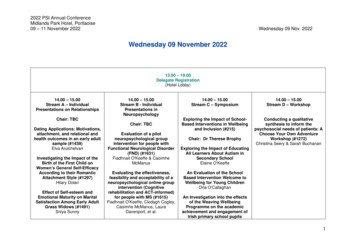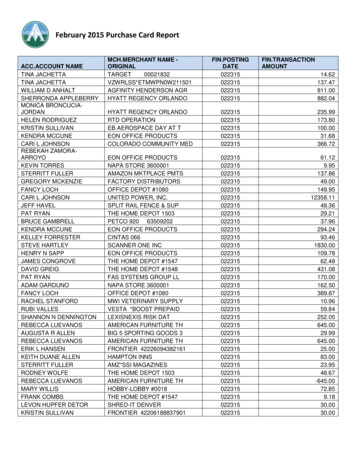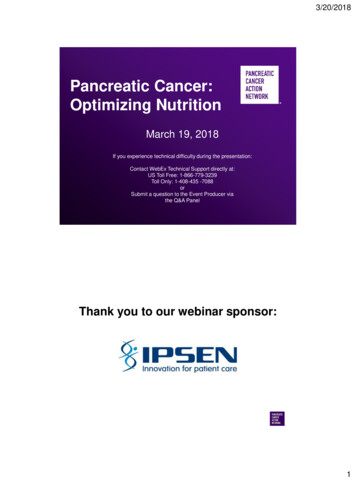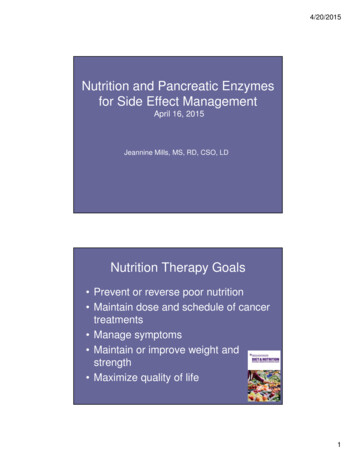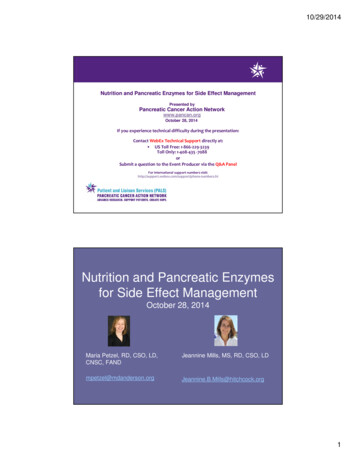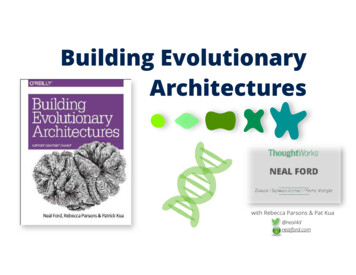
Transcription
Revised: April 10, 2017LEVY ALTERNATIVESPresented by:Rebecca C. Princehorn, Esq.Matthew L. Stout, Esq.Catherine M. Swartz, Esq.BRICKER & ECKLER LLP100 South Third StreetColumbus, Ohio 43215(614) 227-2300160 East Main StreetBarnesville, Ohio 43713(740) 374-22841001 Lakeside Avenue EastSuite 1350Cleveland, Ohio 44114(216) 523-5405201 East Fifth StreetSuite 1110Cincinnati, Ohio 45202(513) 870-6700258 Front StreetMarietta, Ohio 45750(740) 374-2248312 N. Patterson Blvd.Suite 200Dayton, Ohio 45402(937) 224-5300www.bricker.comNote: These materials are for educational purposes only, and are not intended to provide legal advice.4793960v5Ó 2017 Bricker & Eckler LLP
I.INTRODUCTIONOhio School Districts, unlike Ohio municipalities, do not have "home rule" power under the OhioConstitution. In matters of finance, School Districts are entirely subject to the control of the statelegislature. The Ohio Revised Code ("R.C.") strictly limits the ways in which School Districts can levytaxes and borrow money. R.C. 5705.02 limits unvoted property taxes to ten mills (1% of taxable value).Despite these limitations, School Districts have a variety of options for funding both operatingexpenses and permanent improvements. This outline provides an overview of levy alternatives availableto School Districts. Sample ballots corresponding to the alternatives discussed below can be found in theappendix.This outline is intended for educational purposes, and should not be construed as legal advice.Because the nuances of statutes and the particulars of School Districts dictate the exact language requiredfor a levy alternative, each School District should consult with counsel to select the alternativeappropriate for its particular needs.II.R.C. 5705.21 – TRADITIONAL PROPERTY TAX LEVYR.C. 5705.21 permits the Board of Education to submit to the voters a property tax levy thatspecifies a rate of millage. That rate and renewals thereof are subject to the reduction factor of R.C.319.301 (H.B. 920); therefore, School Districts using such a levy will only benefit from new construction,not from the inflationary growth of their tax base over the life of the levy.A.Term; Purpose. The tax may be approved for a maximum of five years, or for acontinuing period of time if for current expenses or general permanent improvements.The levy may serve any one of the following purposes:1.current expenses of the School District;2.a public library supported by the School District;3.a specific permanent improvement1 or class of permanent improvements that theSchool District could include in a single bond issue;4.recreational purposes;5.acquiring and operating community centers;6.operating a cultural center apart from a public school building;7.general permanent improvements2;8.school safety and security; or9.providing education technology.31R.C. 5705.01 defines "permanent improvement" as any capital asset with a useful life, as determined by the schooltreasurer, of five years or more.2Permanent improvement levies may last for a continuing period only if they pay for "general permanentimprovements."4793960v5D-2Ó 2017 Bricker & Eckler LLP
B.Election Proceedings. The procedural steps to place a traditional levy on the ballot are asfollows:1.Resolution of necessity -The Board of Education declares the necessity of thelevy; specifies whether additional, renewal or replacement; specifies RevisedCode section authorizing submission; specifies mills and amount per hundreddollars of valuation; and specifies election date. Two-thirds vote of all membersof the Board of Education required.2.County Auditor's certification -Under R.C. 5705.03, the County Auditordetermines the total current tax valuation and the dollar amount of revenue thelevy will generate in the first year of collection.3.Resolution to proceed -The Board of Education determines to proceed with thelevy; reiterates foregoing information; provides ballot form, including specificlanguage if imposed in the current tax year, e.g. "commencing in ,first due in calendar year ." Two-thirds vote of all members of theBoard of Education required.All of the foregoing documents must be certified to the Board of Elections not less thanninety (90) days prior to the date of the election.4C.Anticipatory Notes. The statute provides for the issue and sale of tax anticipation notesfollowing voter approval of the new levy. For operating purposes, the maximum amountavailable to be borrowed by the Board of Education is fifty percent of the estimatedproceeds of the levy during its first year. For permanent improvement purposes, themaximum amount available to be borrowed by the Board of Education is fifty percent ofthe estimated proceeds of the levy during the life of the levy, unless the levy iscontinuing, in which case the maximum amount is fifty percent of the levy's proceedsover a maximum of ten years.5D.Limitations on Submission to Voters. Under R.C. 5705.214, the Board of Education islimited to three elections per year for the submission of any combination of tax leviesunder: R.C. 5705.194 (emergency levies); 5705.199 (substitute emergency property taxlevy); 5705.21 (operating levies); 5705.212 or 5705.213 (incremental levies); 5705.217(combined operating and permanent improvement levy); 5705.218 (bond issue with levyor combined levy); 5705.219 (conversion levy); and 5748.09 (combined income tax andproperty tax levy).3"Education technology" means, but is not limited to, computer hardware, equipment, materials, and accessories,equipment used for two-way audio or video, and software.4R.C. 3501.01 provides that election dates generally are the first Tuesday after the first Monday in May (Primary),August (Special) and November (General). In presidential election years, the May election is moved to the secondTuesday after the first Monday in March. Prepayment for 65% of the cost of a special election is required. Note thatthe May election could be a special election if there are no contested candidate races.5In connection with the issuance of notes in anticipation of the levy and collection of a permanent improvementlevy, after the School District has spent the proceeds of the notes, a Board of Education having a traditionalpermanent improvement levy for a fixed term or a continuing period may apply to the Superintendent of PublicInstruction under R.C. 5705.216 for permission to issue additional tax anticipation notes for an amount equaling thebalance of the taxes to be collected less the amount of money required to pay the principal and interest on the firstissue of notes and interest on the second issue of notes.4793960v5D-3Ó 2017 Bricker & Eckler LLP
III.E.Renewals. An existing levy under R.C. 5705.21 may be renewed in whole or in part, orcoupled with an increase, at the general election prior to the last year of collection or atany election in the last year of collection. Two or more existing levies may be renewedas a single levy at the primary6 or general election prior to the last year of collection of atleast one of the levies, or at any election in the last year of collection. A time-limitedpermanent improvement levy may be renewed for a continuing period of time. Arenewal levy reimposes the effective rate of the existing levy.F.Replacements. Under R.C. 5705.192, an existing levy (other than an emergency levy)may be replaced in whole or in part, or coupled with an increase, at the general electionprior to the last year of collection or at any election in the last year of collection. Two ormore existing levies may be replaced by a single levy, if both are for the same purposeand all expire in the same year or all are continuing. Replacement of a continuing levymay be at any election in any year after the year the levy is first approved, but only onesuch election can be held during any calendar year. Failure of replacement of acontinuing levy does not terminate the existing continuing levy. A time-limitedpermanent improvement levy may be replaced for a continuing period of time. Areplacement levy reimposes the voted rate of the existing levy, subject to the reductionfactor of R.C. 319.301 just as a new levy would be.G.Rollback. Under R.C. 319.302, the state reimburses School Districts and other politicalsubdivisions for real property taxes for “qualifying levies” as follows: (1) Non-BusinessCredit – 10% reduction in tax for residential and agricultural property; and (2) OwnerOccupancy Credit – an additional 2½% reduction in tax for owner occupied residentialproperty. After September 29, 2013, the following levies are not “qualifying levies”within the meaning of R.C. 319.302: (1) new levies; (2) replacement levies; and (3) theincrease portion of a renewal levy combined with an increase.R.C. 5705.194 – TRADITIONAL EMERGENCY PROPERTY TAX LEVYR.C. 5705.194 permits the Board of Education to submit to the voters a property tax levy thatspecifies a dollar amount to be generated each year the levy is in effect. That dollar amount does notchange during the life of the levy; rather, the millage is adjusted to account for changes in tax valuationresulting from reappraisal or new construction.A.Term; Purpose; Election Proceedings. The tax may be approved for a maximum of tenyears. The resolution of necessity for an emergency property tax levy must: (1) providethat the levy is for the emergency requirements of the School District or to avoid anoperating deficit; and (2) be approved by a vote of the Board of Education and certified tothe County Auditor7. The County Auditor is required to calculate and certify to theBoard of Education the annual levy amount expressed in both mills for each dollar ofvaluation and in dollars and cents for each hundred dollars of valuation, throughout thelife of the levy, that will be required to produce the annual amount set forth in theresolution of necessity assuming that the tax valuation of the School District remains6A "primary" election is defined as an election held for the purpose of nominating persons as candidates of politicalparties for election to offices, and for the purpose of electing persons as members of the controlling committees ofpolitical parties and as delegates and alternates to the conventions of political parties. A primary does notnecessarily occur each year.7The statute is unclear regarding a deadline for certification to the County Auditor. The best practice is to allow tendays.4793960v5D-4Ó 2017 Bricker & Eckler LLP
throughout the life of the levy the same as the amount of the tax valuation for the currentyear. If the Board of Education desires to proceed, it may, not less than ninety (90) daysprior to the date of the election, certify a resolution determining to proceed, along withthe County Auditor's estimate of the required millage, to the Board of Elections. Theresolution to proceed should include the ballot form required under R.C. 5705.197,including specific language if imposed in the current tax year (e.g., "commencing in, first due in calendar year "). It is considered the best practice forsuch resolutions to be passed by a majority of the members of the Board of Education.IV.B.Renewals. An existing emergency levy may be renewed in whole or in part, and coupledwith an increase, at a special (other than February or August) or general election prior tothe last year of collection or at any election in the last year of collection. Two or moreexisting emergency levies may be renewed as a single levy if they expire in the sameyear. Such renewal may be in whole or in part and may be coupled with an increase.C.Anticipatory Notes. R.C. 5705.194 provides for the issuance and sale of tax anticipationnotes following voter approval of the emergency levy. The maximum amount availableto be borrowed by the Board of Education is the proceeds estimated for the first year ofthe levy. The notes may be retired over a period of up to five years.R.C. 5705.199 – SUBSTITUTE EMERGENCY PROPERTY TAX LEVYR.C. 5705.199 permits a Board of Education that currently levies at least one emergency levy tosubmit to the voters a levy to substitute for all or a portion of one or more existing emergency levies (the"substituted levies"). The new levy would, in its first year, be levied in an amount equal to the aggregateproceeds derived from the substituted levies. In subsequent years, the new levy would be levied at a rateequal to the dollar proceeds from the year prior plus a dollar amount equal to the product of the levy'sprior-year millage rate multiplied by the increased value to real property created by construction in theschool district during the current year. As with a traditional emergency levy, a substitute levy will not besubject to the R.C. 319.301 (H.B. 920) tax reduction factors.A.Term; Purpose; Election Proceedings. The tax may be approved for a number of yearsnot exceeding ten, or a continuing period of time. The resolution of necessity for asubstitute levy must specify (1) the annual dollar amount the levy is to produce in itsinitial year; (2) the first calendar year in which the levy will be due; and (3) the term ofthe levy. If the substitute levy relates to two or more substituted levies that are notscheduled to expire in the same year, the resolution must also specify that the existinglevies to be substituted shall not be levied after the year preceding the year in which thesubstitute levy is first imposed. The resolution of necessity must be approved by a twothirds vote of the Board of Education and certified to the County Auditor. The CountyAuditor is required to calculate and certify to the Board of Education the annual levyexpressed in both mills for each dollar of valuation and in dollars and cents for eachhundred dollars of valuation, throughout the life of the levy, that will be required toproduce the annual amount set forth in the resolution of necessity, assuming that the taxvaluation of the School District remains throughout the life of the levy the same as theamount of the tax valuation for the current year. If the Board of Education desires toproceed, it may, not less than ninety (90) days prior to the date of the election, certify aresolution determining to proceed, along with the County Auditor's estimate of therequired millage, to the Board of Elections. The resolution to proceed should include theballot form required under R.C. 5705.199.4793960v5D-5Ó 2017 Bricker & Eckler LLP
V.B.Renewals. At any time, a substitute emergency levy passed for a term of years may berenewed in whole or in part as another substitute levy. Such levy will technically bereferenced as a “substitute for a substitute” rather than a “renewal” levy.C.Anticipatory Notes. R.C. 5705.199 provides for the issuance and sale of tax anticipationnotes following voter approval of the substitute levy. The maximum amount available tobe borrowed by the Board of Education is fifty percent of the total estimated first year'slevy proceeds. The notes may be retired over a period of up to five years.R.C. 5705.212 – INCREMENTAL PROPERTY TAX LEVYR.C. 5705.212 permits the Board of Education to submit to the voters a property tax levy withincremental increases to be "phased in" over the life of the levy. The initial rate of the tax is termed the"original tax." The original tax may be increased by one or more increments, defined as "incrementaltaxes." If there is more than one increment, the rate of the increments must be identical but need not bethe same as the rate of the original tax.Taxes levied under R.C. 5705.212 are subject to the reduction factor discussed above. Accordingto the Ohio Department of Taxation, however, the reduction factor will be applied separately to theoriginal tax and to each incremental tax as it is placed on the tax duplicate, thus permitting the SchoolDistrict to receive some of the benefits of inflationary growth.8A.Term; Purpose; Election Proceedings. Incremental taxes may be approved for acontinuing period of time or for a limited number of years up to ten. Each increment isproposed as a separate rate of taxation, which will expire, at the latest, on the expirationof the original tax. A maximum of five increments may be proposed as part of any onetax levy. The increments will be added, as provided in the resolution of necessity, ineach of the stated years. The election proceedings are similar to those of a traditionallevy.B.Renewals. Incremental taxes, if proposed for a limited number of years, may besubmitted to the voters for renewal8 in the same fashion as other expiring property taxlevies. The renewal rate is the original rate combined with each increment to represent asingle rate of taxation for renewal and may not exceed the combined rate of the originaland incremental taxes. Renewal may be proposed for not greater than ten years or for acontinuing period of time.C.Ballot Form. The form of the ballot for the submission of tax issues under R.C. 5705.212is prescribed by R.C. 5705.251.D.Anticipatory Notes. Voter approval of original taxes or the renewal of such taxesincludes authorization for the Board of Education to borrow up to fifty percent of theestimated first year's proceeds. The anticipatory notes may be retired over a period of upto five years.R.C. 5705.212 does not provide for replacement.4793960v5D-6Ó 2017 Bricker & Eckler LLP
VI.R.C. 5705.213 – PROPERTY TAX LEVY INCREASING BY DOLLAR ORPERCENTAGER.C. 5705.213 permits the Board of Education to submit to the voters property taxes for a specificamount of money each year, which may be increased by a dollar or percentage over the prior year'samount. Taxes levied under R.C. 5705.213 are not subject to the reduction factor but, like emergencylevies, will not produce more than the specified dollar amounts.VII.A.Term; Purpose. This property tax is for current expenses only and is limited to amaximum of ten years. It is presented to the voters as a tax to raise a specific dollaramount of money during the first year of the levy. Increases in years after the first yearmay be presented to the voters as dollar amounts of increases or a percentage increaseover the prior year's amount.B.Election Proceedings. The resolution of necessity for a property tax levy under R.C.5705.213 must be approved by a vote of two-thirds of all members of the Board ofEducation and certified to the County Auditor not less than ninety-five (95) days prior tothe date of the election. The County Auditor is required, as in the case of the emergencylevy, to calculate and certify to the Board of Education the estimated levy expressed inboth mills for each dollar of valuation and in dollars and cents for each hundred dollars ofvaluation for each year the levy is to be in effect. If the Board of Education desires toproceed, it may, not less than ninety (90) days prior to the date of the election, certify itsresolution along with the County Auditor's estimate of the tax levy to the Board ofElections. The form of the ballot is prescribed by R.C. 5705.251.C.Renewals. A tax levied under R.C. 5705.213 may be renewed upon expiration. Therenewal amount tax may not exceed the amount levied during the last year the tax is ineffect prior to the renewal. Renewal can be for a maximum of ten years or for acontinuing period of time. Renewal issues must first be certified to the County Auditor inthe same fashion as initial levies.D.Anticipatory Notes. The statute provides for the issuance and sale of tax anticipationnotes following voter approval of the new levy. The maximum amount available to beborrowed by the Board of Education is fifty percent of the estimated first year's levyproceeds. The notes may be retired over a period of up to five years.R.C. 5705.211 – STATE FUNDING FORMULA CHARGE-OFF PROPERTY TAXLEVYR.C. 5705.211 permits a Board of Education to submit to the voters the question of levying aproperty tax to offset the loss of basic state aid (the funding formula charge-off) resulting from theappreciation of real estate values within the School District.A.Term; Purpose. This property tax is levied for the purpose of paying the currentoperating expenses of the School District. The question of the tax is not submitted tovoters as a specified sum or rate, but instead proposes that the tax be levied "at a ratesufficient to offset any reduction in basic state funding caused by appreciation in realestate values." The tax may be levied for a term of years (not fewer than five) or for acontinuing period of time.4793960v5D-7Ó 2017 Bricker & Eckler LLP
B.Election Proceedings. A Board of Education must comply with the procedures set forthby R.C. 5705.03 with regard to passage of a resolution declaring the necessity of the tax.Such resolution must then be certified to the County Auditor. If the Board of Educationdesires to proceed, it may pass the resolution authorizing the levy of the charge-offproperty tax, which is then certified to the Board of Elections not less than ninety (90)days prior to the date of the election. The resolution to proceed must state the purpose ofthe tax, the first year in which the tax is to be levied, and the term. The tax cannot becertified for a levy on the current tax list and duplicate. The question may be placed onthe ballot at a general or special election; the resolution must state the particular electionat which the question will appear. It is considered the best practice for such resolutionsto be passed by a majority of the members of the Board of Education.C.Levy Rate. A Board of Education is to obtain data from the Ohio Department ofEducation to determine the applicable charge-off increase on which to base the estimatedproceeds of the levy. After the first year of the levy, the estimated additional tax in anyone year shall not exceed the previous year's tax by more than four percent, or a lesserpercentage if so specified within the resolution proposing the tax, excluding increasescaused by the addition of new taxable property.9 The Board of Education is to certify thesum to be collected to the County Auditor before October 1, and the County Auditor mustcertify the corresponding rate as long as such rate does not exceed the four percent (orlesser) limitation.VIII. R.C. CHAPTER 5748 – SCHOOL DISTRICT INCOME TAXR.C. 5748.02 permits the Board of Education, except a Board of Education of a Joint VocationalSchool District, to submit to the voters the question of levying a School District income tax on personalincome of the residents of the School District, regardless of where they are employed, and any estateincome in the School District. Business income is not taxed. If approved, a School District income taxmay be used for School District purposes.10A.Employers' Duties. Employers are required to retain on file the School District in whichemployees reside, and there is no penalty or incentive to verify if information provided iscorrect. An individual not filing or paying the School District income tax will bepenalized under the same provisions covering failure to file or pay the State income tax.B.Parallels to State Income Tax. The income subject to tax and reporting requirements forSchool District income taxes piggybacks the income subject to State income tax filings.Consequently, few additional computations or filings are required.9R.C. 5705.211(C) permits a Board of Education by resolution to reduce the percentage specified in the resolutionlevying the tax at any time following voter approval.10R.C. 5748.01 defines "school district purposes" to include: providing for current expenses, making any specificpermanent improvements or class of permanent improvements, making general, ongoing permanent improvements,providing education technology, operating a cultural arts center, supporting a public library, providing forrecreational purposes, and acquiring property for, constructing, operating, and maintaining community centers. It isimportant to note that the Ohio Department of Taxation has concluded that School District income taxes may not bedirectly used to pay debt service on bonds or notes of the School District (except, of course, where the notes areissued in anticipation of the collection of the income tax).4793960v5D-8Ó 2017 Bricker & Eckler LLP
C.Taxable income. The tax is imposed upon either Ohio adjusted gross income and theestate income of deceased school district residents, or on earned income only.11 R.C.5748.02(E) prohibits the simultaneous taxation of both the Ohio adjusted gross incomeand the earned income of school district residents. Once the Board of Education selectsthe category of income to be taxed and the tax levy is approved by voters, the Boardcannot subsequently propose that an additional income tax be imposed on residents of theSchool District on the alternative category of income.D.Election Proceedings. The procedural steps to place an income tax on the ballot are asfollows:1.Resolution requesting alternative tax rates - The Board of Education must adopt(separately for each election) a Resolution requesting certification of alternativetax rates and specifying which type of income will be subject to tax to producethe amount of funds the School District seeks annually for School Districtpurposes. The resolution must be forwarded to the Tax Commissioner no laterthan one hundred (100) days prior to the election.2.Tax Commissioner certification - The Tax Commissioner must certify thefollowing within ten days of receipt of the Resolution Requesting Certification:1) the income tax rate necessary to obtain the funds needed; and 2) the propertytax rate necessary to accomplish the same.3.Resolution to proceed - Following certification by the Tax Commissioner, theBoard of Education, if it so desires, may adopt a Resolution Determining toProceed with the Income Tax in order to place the income tax, rounded to thenearest quarter percent, on the ballot. The proposed levy may be for a specifiednumber of years or for a continuing period of time. Passage of the ResolutionRequesting Certification alone does not obligate the Board of Education to passthe Resolution to Proceed. The Resolution to Proceed must be adopted andcertified to the Board of Elections at least ninety (90) days prior to the electiondate. The Board of Education cannot place on the ballot an income tax rate loweror higher than that certified by the Tax Commissioner. The Board of Educationcan always choose to place on the ballot a property tax at any desired rate(regardless of the rate certified by the Tax Commissioner).E.Limitations on Submission to Voters. Under R.C. 5748.02(D) the Board of Education islimited to two elections per calendar year for submitting a School District income tax toits electors. If the Board of Education does submit the question twice in a calendar year,one of the elections must be the November (general) election.F.Effective Date. The effective date of a School District income tax is January 1 of thecalendar year specified by the Board of Education and may include the year following thedate of election.11Ohio adjusted gross income includes both earned income (wages, salaries, tips, self-employment) and unearnedincome (interest, dividends, capital gains and retirement benefits). Earned income includes only wages, salaries,tips, other compensation and earned income from partnerships and self-employment, all to the extent included inOhio adjusted gross income. Earned income does not include distributive shares of profit from an S corporation.4793960v5D-9Ó 2017 Bricker & Eckler LLP
G.Increases. Increases in the income tax rate must follow the above-outlined procedures,but do not require repeal of the current rate.H.Board-initiated Decreases. The Board of Education may pass a resolution reducing therate of the income tax by a multiple of one-fourth of one percent. The effective date shallbe the first January 1 occurring sixty days after certification of such resolution to the TaxCommissioner.I.Renewals. An expiring income tax, or income taxes expiring on the same date, may berenewed and so labeled on the ballot, provided the rate being proposed is the same.There is no limit on how early a renewal income tax may be placed on the ballot.J.Conversions (Replacements). An existing School District income tax, regardless ofwhether time-limited or continuing and regardless of whether approved singly or incombination with a bond issue, may at any time be converted from "all income" to"earned income only" upon voter approval. The amount of annual revenue to beproduced may be the same, or more or less than, the amount raised annually by theexisting tax. The term of the replacement income tax may be for a specific number ofyears or continuing, but the replacement income tax must have the same purpose as theexisting income tax. Failure of replacement of an existing income tax does not terminatethe existing income tax.K.Advantages. Advantages of School District Income Tax over Property Taxes:L.1.it tends to have the people using the School District (residents as opposed tobusinesses or non-resident taxpayers) pay the bill;2.it reduces the burden on fixed income families;3.it allows for growth as incomes increase; and4.the estimated proceeds of the income tax are not included in the ballot language,only the rate of tax.Disadvantages. Disadvantages of School District Income Tax Compared to PropertyTaxes:1.businesses not subject to tax;2.high income families may pay more than if a property tax were levied;3.the cost of collection is higher (the State assesses a 1.5% administrative fee);4.School Districts lose interest income due to the method of collection (the Statemakes quarterly payments and, during the first year of the income tax, pays theSchool District over an eighteen month period);5.city officials may oppose it because it infringes on the municipality's traditionalrevenue source;4793960v5D-10Ó 2017 Bricker & Eckler LLP
M.6.there are no penalties for employers to force compliance;7.revenue is more difficult to project
Columbus, Ohio 43215 (614) 227-2300 1001 Lakeside Avenue East Suite 1350 Cleveland, Ohio 44114 (216) 523-5405 258 Front Street Marietta, Ohio 45750 (740) 374-2248 160 East Main Street Barnesville, Ohio 43713 (740) 374-2284 201 East Fifth Street Suite 1110 Cincinnati, Ohio 45202 (513) 870-6700 312 N. Patterson Blvd. Suite 200 Dayton, Ohio 45402

